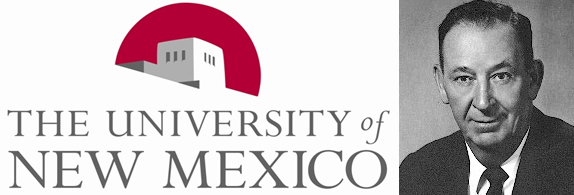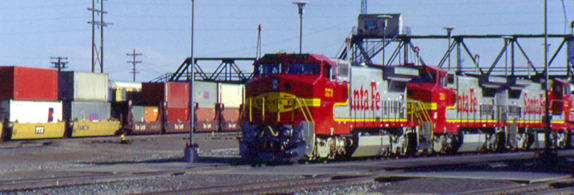But For a Coat of Paint

We’d just driven over Navajo Dam in north central New Mexico, marveling at the water in Navajo Lake, diminished by the drought but still voluminous if a bit sinister with its milky blue color.
Thoughts of air pollution from the Four Corners power plants, the gridlock of tens of thousands of fume-spewing oil and gas jack pumps, and air borne mercury contaminating fish in the lake, unsettled us as we drove through Rio Arriba County on New Mexico 64 and 537. But it was one of those clear, far-viewed New Mexican mornings, clouds building over pinion forests and vistas all the way to the Chuska Mountains in Arizona.
The land’s magnificence seems to absorb fears and depressions, all negative thinking, and turn their energy into a kind of meditative attentiveness.
A few miles past the dam we started to see oil and gas storage tanks in the woods. We were dismayed at first. But then we connected with our senses more intimately and realized we weren’t as offended as we might be.
The storage tanks and the pumps and all the equipment were painted a flat green, and for all intents and purposes blended fairly well into the treescape and scrub.
The more we saw them dotted here and there in the forest, the less we minded them aesthetically, and the more a strange sensation of curious admiration replaced our annoyance. Had some fossil fuel corporation hired an exec with a little aesthetic conscience? Did someone think camouflaged tanks would take the edge of cattle growers’ anger at the pumps and their waste poisoning their livestock?
It didn’t take long, once we got home, to find out that it wasn’t a corporate inspiration. It was a government regulation. It wasn’t much but it’s so much better than nothing that it turns out to be quite a bit. And it wouldn’t have happened without the regulations passed by the Rio Arriba County Commission.
The Commission mandates that all applications for oil and gas development have a “visual mitigation plan” that includes “vegetative screening,” “strategic use of natural terrain features,” and a requirement that “all above ground tanks must be painted a flat green or tan color” depending on the dominate hue of the landscape.
Several sites down the road, where those regulations were not met, ones filled with terribly corroded old white colored tanks with really hideous orange guck seeping out of them, showed us how depressing our drive might have been through the wooded highlands without those county regulations.
San Juan County, where most of the pumping occurs, has no aesthetic codes or any county ordinances at all governing oil and gas development, using state and federal regulations as their guidelines.
It doesn’t take an art critic to tell the difference between other pump fields we’ve driven through around the state and the almost unobtrusive pumps in Rio Arriba County. It’s like comparing a much loved and well treated old VW with a wreck in a junk yard.
Anyone who drives through the Rio Arriba landscape can clearly see that government is not the problem.
Tom Popejoy

University of New Mexico President Tom Popejoy gave UNM one of its finest hours over 50 years ago when he defended academic freedom and the constitutional rights of his students and faculty at the State Convention of the American Legion in Carlsbad in the summer of 1962. It was a hostile audience, but Popejoy braved the crowd and spoke the plain truth.
His speech was entitled “Second Class Citizenship” and with it he refused to cave in to pressures to limit the free speech and free inquiry of UNM’s students, its student newspaper, and its faculty.
It was a time of great turmoil in universities across the nation. The Red Scare and McCarthy era witch hunts were still bedeviling the country. Since the end of WWII and the Truman administration’s creation of loyalty oaths to prove that Democrats and liberals were good Americans too, many states had came to require such oaths from all public employees, including university professors.
And with the aura of the dreaded House UnAmerican Activities Committee (HUAC) prowling around, holding hearings across the country, weeding out “subversives” and causing teachers and movie people and others in the l950s to lose their jobs, and still creating black lists and gray lists into the mid l960s, opposing loyalty oaths took tremendous courage. In fact, if you were on the left of the political spectrum just speaking your mind at all was an act of conscience and defiance.
Two years after Popejoy’s American Legion speech, the U.S. Supreme Court would strike down the state of Washington’s loyalty oath requirements in a political climate that was finally turning from Hard Right extremism. President Popejoy was among those academic leaders who, with great dignity, self-control, and persuasion, had led the way and said enough is enough.
In l962, however, UNM was “in the doghouse,” as Popejoy said, with the Legion and other groups for having a number of professors who adamantly opposed loyalty oaths, who spoke their minds about politics, and weren’t about to be intimidated. And UNM also had a student editor of the Daily Lobo, Mark Acuff, later the legendary editor of the New Mexico Independent, who refused to be censored.
Conservative groups were furious and were calling for legislative investigations of the university to shut up and maybe fire “disloyal” and “un-American” subversives. Using language turned almost into a joke by HUAC’s political nitpicking, Popejoy told the Legion crowd, “I recently stated publically that all of the faculty members who have been involved in controversy, who were healthy and within the appropriate age limits, served with distinction during World War II. Additionally, I would like to call your attention to the fact that our present faculty is literally saturated and infiltrated with war veterans. Many of them belong to reserve units, and several belong to veterans’ groups such as the Legion.”
The intensity of the rage against UNM is seen in this genteel sentence from President Popejoy who said that even though he was a “chronic golfer” used to “rugged communication,” “What some people have said privately, and, on occasion, in large groups, is not suitable language for me to repeat here or elsewhere.”
The controversies involved “questions surrounding the rights of faculty members and student editors to express themselves within the rights given to them by the Constitution of the United States. “
“During these turbulent times it has been my purpose to defend members of the faculty and the student body, even though I may not necessarily have agreed with their statements.”
He continued, “It goes without saying almost that a university is a place of learning, where students and faculty members in an uninhibited way are searching for the truth. A university becomes great then when the quality of the faculty and the student body is high – when the faculty and students work in an atmosphere of freedom – freedom to learn and freedom to teach without any interference.”
“As I said before, you cannot have a first-class institution without a first-class faculty ….There are some writers in this state who are ambidextrous. With one hand they write that faculty members have the right to take sides on public issues, but with the other they write the faculty members are a bad influence on the students in their classes. Continued strife due to this type of thinking will drive competent and imaginative faculty members from the state. They do not believe in second-class citizenship. Brilliant and exciting students will seek their education outside the state. In many instances they will not return.”
Then President Popejoy pressed the issue home quoting, brilliantly, the National Commander of the American Legion, Charles L. Bacon, who observed “For all of us who have lived under a thought-controlling dictatorship, the right to disagree is precious. The freedom to uphold a minority opinion is the true essence of democracy. Freedom to disagree is the Promethean spark which keeps America’s creed alive.”
Popejoy started winding up for a conclusion with a folksy but pointed joke. “Some patriot asked me the other day, ‘Do you teach about communism at the University.?’ I said, ‘Yes, we do. We will also teach courses in our medical school about cancer and insanity.”
Later he told the Legion, “Fortunately, the University of New Mexico…[is]not subservient to a police state. We are not in the business to make ideas safe for students. We are interested in a vigorous program of higher education which will make it possible for students to accomplish critical and objective thinking when confronted with suggestions and ideas. A free university can afford heresy, but it cannot tolerate the dictates of a conspiratorial government.”
After talking about Hitler and Stalin’s “thought control” and deftly painting Red Scare witch hunting with the same brush, President Popejoy took after HUAC in an elegant, if indirect way. He quoted himself from his inaugural address as president in l949, “Among the faculty of a sizeable university one may expect to find all shades of political opinion. The constitutional right of every American to choose his own political philosophy cannot be denied to university professors as a class. There is, however, no place in a university faculty for a teacher who, under the cloak of academic freedom, works actively to promote a form of government which would destroy the very privileges which he enjoys.
President Popejoy affirmed to the American Legion “I have not changed my mind in regard to this fundamental principle.”
Two years later, the Supreme Court agreed with him.
Critters We Have Known: Bagworms in the Air

When you first encounter a bagworm chances are it might seem to be suspended in mid air, a strange acrobatic bundle of little leaf bits, pirouetting perhaps but otherwise swaying with the breezes.
It’s quite fantastic. And utterly fascinating to amateur naturalists on their daily walk. The bag worms hang from trees over sidewalks or ditch paths on a nearly invisible filament that must extend sometimes twenty to thirty feet.
At more fanciful moments bag worms can look like little ballerinas dressed up in leaves to resemble woodland fairies. But once you give them a good look, fancy is replaced by fascination. Popping out the top of the elongated, diamond shaped object is a little caterpillar, busily spinning and descending or rising on his filament.
The leaf covered cocoons are little bags, made out of that sticky fiber, in which the caterpillars will eventually metamorphose into moths. The world has some 1,350 species of bagworms. And they adorn themselves with what’s available in their habitats, some with twigs, some with sand, some with bark.
If you watch them closely enough you see that the caterpillar, dangling from his invisible filament in his little leafy cocoon, winds up that filament into a gossamer ball as he moves back up into the tree. The filament ball must be used to make the cocoon but we’ve never actually seen how that happens. But we do know that up the filament he goes, and down he comes again to make another gossamer ball, and so on until he has a cocoon built to his genetic specifications.
And we also know that the cocoon and the creature in it are incredibly tough. Early on we found a cocoon on the ground and took it home. We placed it on the kitchen table with the thought of dissecting it later. The following morning, the cocoon was gone, or so we thought. Had the cat gobbled it up? No. A few days later we found it attached to the top of a window frame, blithely, I’m tempted to say, becoming what it was destined to become.
Individually, or spaced apart several hundred yards, the bagworm is a charming critter, inspiring whimsy, and even silly images of pixies flying in mid air.
But like anything else in life, though bag worms separately are a marvel of complicated genetic behavior, in mobs they can kill off a small tree in a season.
We’ve seen many hundreds of them this year on a single denuded tree in a front yard near the ditch. They must thrive in moister weather.
For amateur naturalists, the bagworm is like an unexplored continent full of mysteries, the beauties of the ingenuity of natural selection, and I’m sure, darker truths and realities to be plumbed.
Model Trains in Belen

It was like being a kid and taking off on your bike to points unknown, leaving school and parents and all complications behind. We’d rediscovered the joys of an afternoon escape. We got in the car and suddenly were nowhere to be seen. When we reappeared we were in Belen at the old Fred Harvey House right by the enormous Burlington Northern Santa Fe Railway hub.
We’ve become admiring train enthusiasts in our old age. And, now, it turns out, we’re even rather in love with model trains – and all because of Belen.
Until l918, the route from Chicago to L.A. went over Raton Pass, a daunting, drudge of climb that made the city of Las Vegas into the great railway hub of New Mexico. Raton Pass was bypassed when the Belen Cutoff was laid out, between Texico on the New Mexico/Texas Border and Dalies, southwest of Albuquerque, Belen took over from Las Vegas as the major rail hub in the state. Las Vegas was stranded and impoverished, though it remained not only the capital, so to speak, of the indigenous Hispanic heartland of the mountain west, but also feisty, resourceful, and proud. It’s the home of more historic buildings today than anywhere else in the state, a cosmopolitan place with a university, two fine libraries, and a will to prevail over chronically hard times.
Belen became the great train inspection station stop after Barstow, California, with thirteen tracks, massive reservoirs of fuel, and capacities to switch cars around between trains to streamline the loads and increase potential velocity, which, on the flat, can sometimes reach, we’re told, up to 70 miles an hour, even when the cars themselves add up to a load over 10,000 feet long. When the economy is good as many as 90 or more trains can pass through Belen in a day. After the Great Recession of 2008 the numbers dropped into the 60s on average.
Driving in Wyoming as we do, we often find ourselves in Laramie with its great train yard and pedestrian bridge, which lets us stand over the tracks as trains go barreling underneath. Once in Essex, Montana, a favorite stop for train connoisseurs we saw what real trains nuts are like, with their cameras, and their fine-tuned knowledge of tracks, switches, engines, and cars. One man we met told us he tries to ride 100 trains a year.
In Belen you can get the feeling of what it was like in the heyday of train transportation by hanging out in the old 1910 Fred Harvey House, with its alluring memorabilia, and salvage from the wreckage of the old Alvarado Hotel, Albuquerque’s magnificent Harvey establishment which was torn down in the l970s.
But it’s in the back room of the Harvey House where kids, and kids at heart, can get off their bikes, rest a while, and find a real escape. In two rather long and narrow rooms, the Belen Model Railroad Club has laid out its multiple tracks and engines and rail cars through beautifully painted and crafted representations of virtually every landscape, urban, suburban, rural, and natural, that New Mexico has to offer, and all in exquisite HO gage detail.
It’s hard not to feel the wonder of being eight again when the engineer starts up those little trains with their long lines of box cars, and they move right before your eyes over the countryside, past the main street, past the crossing with the fetching young woman by her convertible with her suitcase eternally waiting for her train to arrive, past the little houses with their ducks and cattle, past the farms, then disappearing into a tunnel and reappearing in the other room for further adventures, rather like Alice Through the Looking Glass, or for that matter, like we did when one minute we were fleeing duties in Albuquerque and the next found ourselves riding the rails in Belen.
(Creative Commons images via Flickr. Oil storage tank by Roy Luck. Bagworm by Kristine Paulus. Train by rails4me.)




Responses to “Provincial Matters, 8-13-2013”